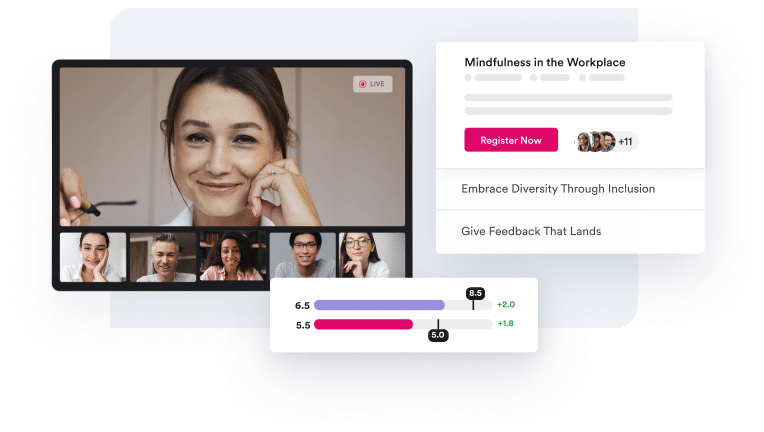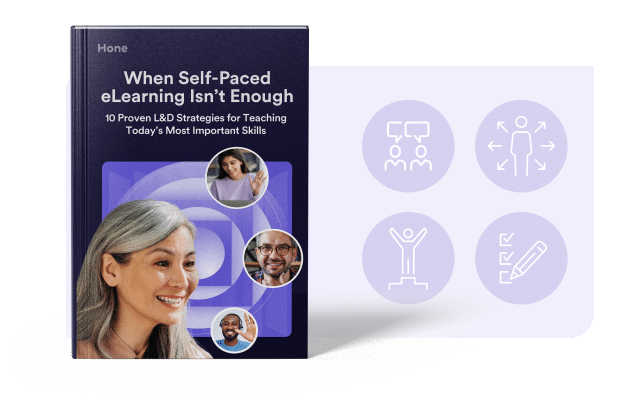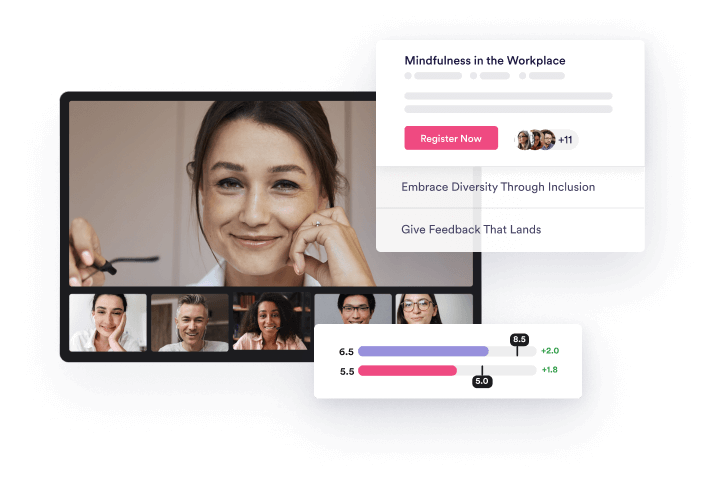How often do you get direct access to advice from a group of world-class L&D experts? Our guess: Probably not often! As businesses strive to stay competitive in a quickly evolving market, L&D leaders need to go beyond the usual and become strategic partners within their organizations. So we’ve pulled together advice for L&D leaders from a variety of thought leaders, consultants, authors, and more to guide you.
Their advice can help you reshape strategies and drive meaningful growth in your organizations. Let’s explore the collective wisdom these experts share about what to change, what to start, and what to keep doing to help L&D leaders succeed in a fast-changing learning environment.
But before we dive in, let’s quickly introduce our experts.
What should L&D leaders stop doing?
Stop getting so distracted from what you know works
Jenny Dearborn has a down-to-earth reminder. Don’t get too carried away with the latest flashy trends in learning and development. Organizations sometimes splurge on what’s hot at the moment, thinking it’ll make them look good and up-to-date.
A lot of money is spent on the coolest, newest, and jazzy distraction. Sometimes people think that makes them look good and that they’re current and going with the latest thing, but actually it’s the opposite. What makes you credible is following that logical process of problem, solution, and result.
It’s all about tackling real problems with smart solutions and showing concrete results. So instead of chasing after every shiny new thing, she suggests sticking to a plan that actually gets stuff done.
Stop ignoring virtual communication skills for employees
Cindy Huggett makes a great point: Just because folks have been working online for a while doesn’t mean they’re automatically ace at it. We shouldn’t assume everyone’s a pro at online communication and presentation skills. It’s like assuming everyone’s a natural on camera, when that’s not always the case.
“I think learning leaders need to stop assuming that just because a lot of people have been online and remote for the last few years, that they’re equipped to be online well. I think we make the assumption that somebody can show up on camera and deliver or get their point across, when really that is a skill that not everybody has,” she says.
Cindy thinks we’re missing out on a chance to help folks improve in this area. She suggests that organizations should stop assuming everyone’s got these skills and instead offer training and support to help them excel in the virtual world.
Stop being just a teacher and become a strategic partner
Instead of just focusing on teaching, learning leaders should become real partners in the business. Jess Yuen says they should dive into understanding how the company makes money and keeps customers happy.
“Start thinking about being that business-minded thought partner [with your execs] and understand the business — really deeply understand the business because we care. So get curious about their business metrics and their business fundamentals, and really dive into how the business is earning money and retaining customers. Get in there with them, because I think it’ll lead to even better insights and even better programs for helping your employees learn.”
By getting deeply involved in the business side, learning leaders can create better programs that really help employees learn and grow.
Stop focusing on ROI over real value
This will probably get a few people talking, but I think [L&D leaders should] stop focusing on ROI and start focusing on value.
Rob Lauber says that focusing on ROI means looking back after spending money to see if it was worth it. Instead, he thinks we should figure out what success looks like before we even start. By doing that, we can set ourselves up for success right from the beginning, rather than just hoping for a good return later on.
Stop making feedback collection harder than it needs to be
Julie Dirksen says that we shouldn’t always insist on getting feedback from everyone involved in a learning program.
“Stop insisting that the only legitimate form of evaluation is derived from their entire audience, and look at some smaller, cheaper ways to get more feedback. It could be follow-up interviews, or Brinkerhoff Success Case Method is a nice one where they do a survey and then look at people who have adopted and people who haven’t adopted and do some targeted interviews with those.”
Julie believes we shouldn’t just focus on quantitative feedback but also take the time to hear people’s stories and experiences to get a fuller picture of what’s working and what’s not.
What should L&D leaders start doing?
Start taking a seat at the stakeholder table
Mike Rognlien encourages L&D leaders to think big picture. He suggests they consider the broader business context when deciding what learning content to focus on. Rognlien advises L&D folks to get involved in discussions about what’s expected and who’s accountable. He believes this involvement helps align learning efforts with what the business needs and ensures they’re on the right track.
He says, “If you’re not involved in the conversations about expectations and accountability, you really should start the proverbial seat at the table. I don’t care if you have to bring your own chair and your own side table; get in that thing so that when those conversations about expectations and accountability are happening, you’re a key partner to them.”
Start spending more time on your own learning
Jess Yuen thinks L&D leaders should spend more time learning. She understands it’s tough to find time amid competing priorities, but it will really benefit L&D professionals in the long run.
“Even though I love learning, it’s hard to make time for it. And I think sometimes when we do it in our day jobs, we don’t prioritize it as much as we would like to. And so I wonder if learning leaders could spend even more time learning about newer approaches and the tools. These are rapidly shifting in our space. Whether it’s amazing programs like Hone’s or playing with AI tools, I think major changes are afoot,” she says.
Yuen suggests L&D leaders should explore new methods and tools in their field, like Hone’s programs or AI tools. She says things are changing fast, so staying curious and learning more will really help.
Start engaging more with your learners
L&D leaders must collaborate more with the people they’re trying to teach. This means really understanding what those learners need and what’s going on in their lives. It’s not just about asking for feedback; it’s about really listening and watching how they learn.
L&D leaders really need to be engaging more with the audiences or encouraging their staff to engage more with their audiences and find out what’s really important or what’s really going on with them.
By doing this, L&D leaders can create learning experiences that fit the learners’ needs better. Encouraging team members to do the same helps everyone work together to make learning experiences that really help people.
Start supporting managers in nurturing a culture of learning
When managers prioritize learning, teams become more adaptable and collaborative, leading to greater success.
Help managers be better stewards of learning. They are the organizational glue. They’re sort of our force multipliers in our organizations.
This boosts employee motivation and retention while fostering a sense of teamwork and achievement. Ultimately, investing in managers’ support for learning benefits both individuals and the organization as a whole.
Start getting feedback from outside of your organization
Will Thalheimer also urges L&D leaders to make it a habit to seek feedback from outside sources on how they’re doing with their learning efforts.
“We should also start getting more outside objective feedback on our learning practices. We go to the doctor every year to get checked out. We bring in our car every year to get checked out. It’s good to get checked out,” he says.
Getting input from others helps us spot areas for improvement, fine-tune our methods, and keep growing. So, think of it as giving our learning strategies a regular tune-up to keep them running smoothly.
What should L&D leaders continue doing?
Continue leveraging virtual collaboration for learning
We’ve really improved our use of virtual classroom tools like polling and chatting, making our sessions more interactive. But Cindy Huggett urges L&D professionals to not just use them for the sake of it — they should add something meaningful to our discussions.
“I think we should continue using [virtual classroom tolls, like polling and chatting] with a caveat. We’re not using them just to use them, but we’re using them to further the conversation,” Cindy says.
When you break learners into smaller groups or use collaborative whiteboards and polls, do it with a clear purpose in mind. That way, you can keep the conversations going and make the most of your learning time together.
Continue experimenting with new technology…
Will Thalheimer recommends that L&D leaders keep trying out new technology because there are so many exciting possibilities out there. When it comes to online learning, there’s still a lot we can do to make it better. There are new tools popping up all the time, but we’re still figuring out the best ways to use them.
There’s new tools out there, but we’re in the pioneer phase. I can see myself getting better at it and everybody else as well, so we should continue doing that.
It’s like learning any new skill — the more you practice, the better you get. So, let’s keep exploring and pushing the boundaries of what’s possible in education.
…but don’t forget about the benefits of doing it yourself
Julie Dirksen urges L&D leaders not to get too caught up in the latest shiny gadgets and forget about the hard work we’re already doing. Making content is one of those things that helps us learn a lot along the way. Even though AI can do a lot for us, there’s something special about putting in the effort ourselves and really thinking things through.
She says, “I don’t always know what I think about a thing until I’ve worked through the act of writing about it, or creating presentation about it, or really working through it. And so the idea that we’re just going to magically create content, and we’re not going to be doing that sort of effortful process around it I think is not the whole picture, and so still placing value on that is something that’s useful.”
What can L&D leaders do to stand out in their role?
Know your strengths and weaknesses, and be transparent about them
Rob Lauber believes it’s crucial not to cling too tightly to your current practices and methods. L&D leaders must be open to self-critique and willing to scrutinize your work. Identifying our areas for improvement and acknowledging them openly is key.
His advice: “Don’t hold anything that’s in your purview precious to you. Be willing to be the bigger critic of your work than your stakeholders will be. Know where your shortcomings are, know where your opportunities are to get even better as a learning leader or as a learning function in the organization, and visibly talk about those before other people say it. And I don’t mean it in a self-deprecating way, but every learning organization has challenges.”
When we honestly evaluate what we’re good at and where we can do better, we can help our teams keep growing. It’s important to talk about these things openly — not to make ourselves feel bad, but to help everyone learn. Being transparent helps us keep getting better and finding new solutions to problems.
Become a data storytelling expert
L&D leaders can really stand out in their role by getting better at showing data in a visual way and telling stories with it. To hone this skill, Jenny Dearborn says, “a super easy thing would be taking a class on how to present data visually, and visual storytelling of data and information.”
Find learning opportunities where you can pick up tips on making charts and graphs that are easy to understand and learn how to tell stories with data, making it more interesting and easier for others to grasp. Learning these skills helps learning leaders not only with their own presentations but also in guiding their teams to communicate data effectively.
Focus on your unique value as a learning leader
Mike Rognlien says L&D leaders should ask themselves a question to figure out how to stand out in their role: “What is the organization’s unique culture, and what unique experience do I bring to help bring that culture to life?”
Mike believes that a lot of learning leaders spend too much time trying to sound like business experts, talking about finance and products, but that’s not why you’re there as a learning leader.
We have to have the confidence that we are there for a reason, that the stuff that we bring to the table is just as valuable. And just really have the confidence that you are there because you meet a business need — just as accounts payable meets a business need; just as an engineer shipping a product meets a business need — and really doubling down on that.
Success as an L&D leader comes from being great at what we do, not from trying to do someone else’s job. Let’s focus on rocking our own skills and making a real impact where it counts.
Get even more advice from these experts
The wisdom shared by these seven industry experts paints a clear picture for L&D leaders to follow on their journey of improving workplace learning. By letting go of old habits, diving into new strategies, and staying committed to nurturing a learning culture, you can steer your organization toward continuous growth.
And this is just a fraction of what these amazing minds have shared with our team! You can check out each of their full Learning Works podcast episodes below.















